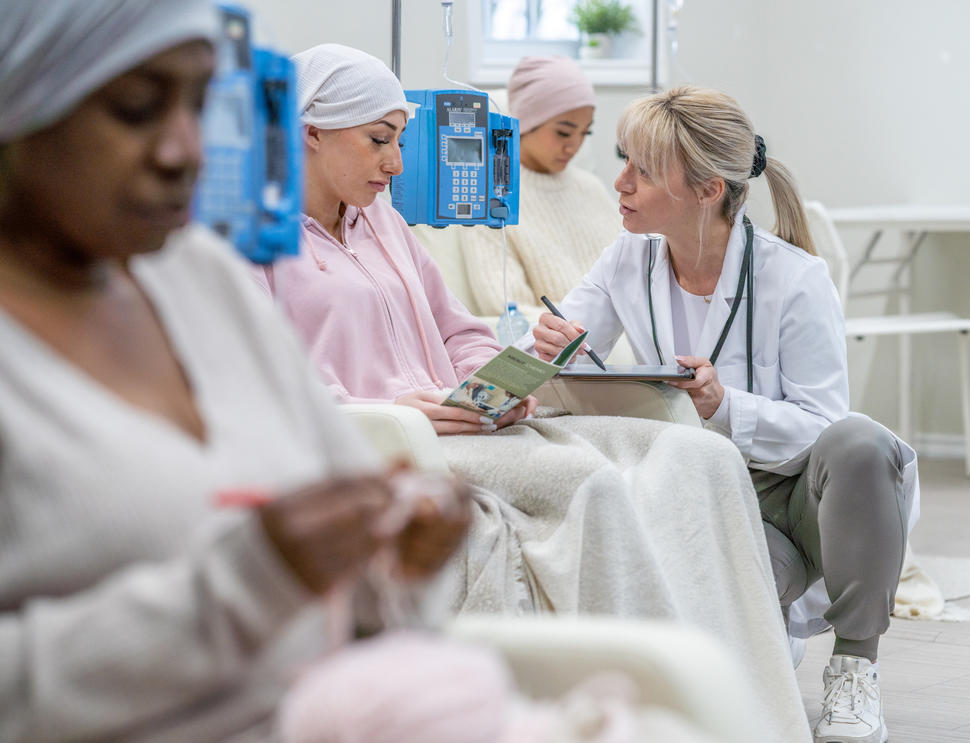Program Connects Adolescents and Young Adults to Quality Cancer Care
, by Sharon Reynolds
From puberty to leaving home, starting a career, and navigating adult relationships, adolescents and young adults can feel like they’re facing a seemingly unending stream of challenges. Now imagine adding cancer to that mix.
Every year, almost 90,000 of these adolescents and young adults (AYAs)—generally defined as people between the ages of 15 and 39—receive a cancer diagnosis. And this group of patients often needs extra help navigating the complexities of cancer care.
A new study has shown that a program in place for a decade at the University of North Carolina (UNC) Lineberger Comprehensive Cancer Center substantially increased its assistance to AYAs with cancer being treated at the center. For example, there were large increases in the number of AYAs who underwent fertility counseling, a particularly important consideration for this age group. The program also substantially boosted AYA enrollment in clinical trials and helped more AYAs get other care recommended by national guidelines.
The UNC team is now working to standardize many components of the program so it can be adapted by other cancer centers, explained Jacob Stein, M.D., M.P.H., who presented the findings from an evaluation of the program in September at the American Society of Clinical Oncology’s Quality Care Symposium.
“A lot of [centers] are now reaching out and asking: ‘How do we do this?’” said Dr. Stein. And the timing is right for the wider availability of programs to help AYAs with cancer, he added.
“Studies are showing that cancer is on the rise in younger adults,” he said. “That’s a concerning trend, but there are a lot of folks now engaged and talking about cancer in AYAs in a way that we weren’t 5 or 10 years ago.”
From one patient to a new program
The cancer center’s AYA program started with a 14-year-old with a rare cancer named Sophie Steiner, who came to UNC for her cancer treatment in 2014. Even though she was a teenager who enjoyed dance and photography, she felt that her surroundings in the hospital—pink elephants and clowns on the walls—and the overall care program was geared toward children.
“She unfortunately passed away from her disease,” Dr. Stein explained. “But [before that], she told her parents: ‘The health system does not take particularly good care of young people, so I want you to try to do better.’”
In response to their daughter’s request, the Steiners founded the Be Loud! Sophie Foundation, which helped the UNC AYA Cancer Program get off the ground that year with a single social worker.
“Now, in 2024, we have 11 members on our team,” Dr. Stein explained, including nurse practitioners, a fertility counselor, and a psychologist.
Although it’s grown, the program doesn’t have the resources to reach out to every AYA who gets cancer treatment at UNC Lineberger. But not every AYA with cancer needs the same kind of help, Dr. Stein explained. AYAs are a diverse population with diverse needs, some much more intense than others. Teens may need extra help keeping up with the daily demands of school, while young adults often face financial difficulties or a lack of adequate support systems.
“A 16-year-old with Hodgkin lymphoma who’s living at home with their parents is so different from a 37-year-old with two kids and early-stage breast cancer, or a 25-year-old with advanced osteosarcoma,” Dr. Stein said. “We focus on connecting with folks who we think are at the highest risk for running into trouble during their cancer treatment. Then we very much tailor [our assistance] to their needs,” he added.
Between 2015 and 2022, about 4,000 people ages 13 to 39 were seen at UNC. Over this time, the program went from connecting with 6% of people in this age group to more than 25%. Compared with those not participating in the program during this period, participants were more likely to be young, unmarried, Black, and have advanced cancer or a blood cancer like leukemia—all groups likely to need more attention from the health care system, Dr. Stein said.
Despite the high clinical needs of the program participants, they were more likely than non-participants to receive guideline-recommended care—including enrolling in clinical trials when appropriate. Between 2015 and 2022, almost 45% of AYAs who participated in the program enrolled in a clinical trial, compared with 26% of non-participants.
In addition, AYAs who participated in the program were substantially more likely to receive other types of guideline-recommended care, including fertility counseling, palliative care, and advanced care planning consultations.
Common challenges for AYAs with cancer
About half of NCI-Designated Cancer Centers now have some sort of program in place to help AYAs navigate the complexities of treatment, said Jeanelle Folbrecht, Ph.D., a clinical health psychologist who founded the City of Hope Children’s Cancer Center AYA program.
City of Hope also started its program about a decade ago. Every AYA program in the country today has different methods of reaching out to and working with patients, Dr. Folbrecht said, but financial help, fertility preservation, and school and career issues are consistently the most common areas of need and assistance.
Her program has also chosen to focus on helping AYAs get peer support.
“AYAs talk a lot about wanting to connect with people who understand what they’re going through,” Dr. Folbrecht said. “So, we try to connect them to resources, but we also try to connect them with each other.”
Those connections, she explained, are made with activities like online groups, camps, and bimonthly in-person meetups.
Expanding access to AYA programs and services
Hospitals big and small face multiple barriers in establishing and maintaining programs for AYAs with cancer, said Emily Tonorezos, M.D., M.P.H., director of NCI’s Office of Cancer Survivorship. One big barrier is cost, she added.
Leveraging technology is one way to potentially address cost issues, Dr. Tonorezos continued. For example, she explained, NCI is funding a study that is testing a web-based resource for helping AYAs cope with the distress that often accompanies a cancer diagnosis, and another testing whether an online tool can help AYA’s undergoing treatment manage their symptoms.
“Not only can these interventions potentially help lower costs for hospitals and individuals, but they might also allow us to provide this help to more people,” she said.
Nonprofit groups such as Teen Cancer America are also now helping fund AYA cancer programs at hospitals that want to start such programs, said Dr. Folbrecht.
Despite the increased momentum to build support systems for AYAs with cancer, many will still be treated at a hospital without such a program and will need to advocate for themselves, she added. That includes asking lots of questions, she advised. “Is this [treatment] going to affect my fertility, and what can I do about it? Ask about financial resources. Ask about clinical trials,” she said.
And they should not hesitate to get a second opinion if they feel that is the best thing to do, Dr. Folbrecht said.
“You want to make sure you and your physician are working towards an effective treatment [plan], and also preserving your quality of life and all the things that are important to you.”

